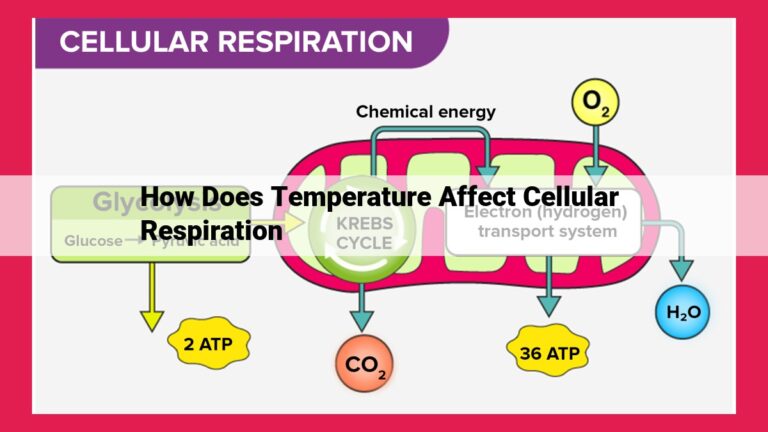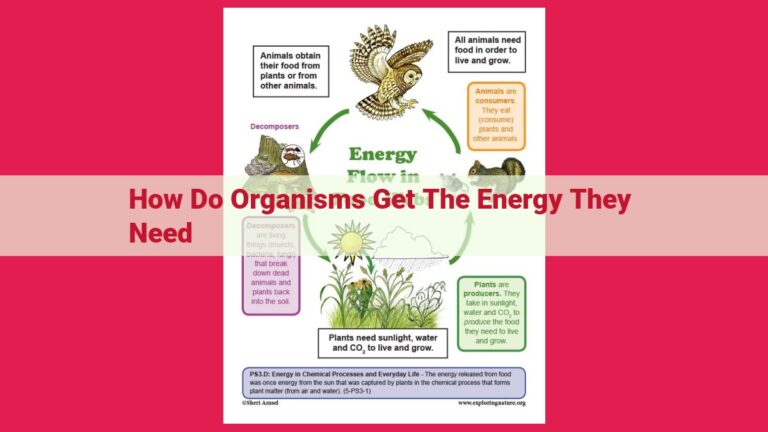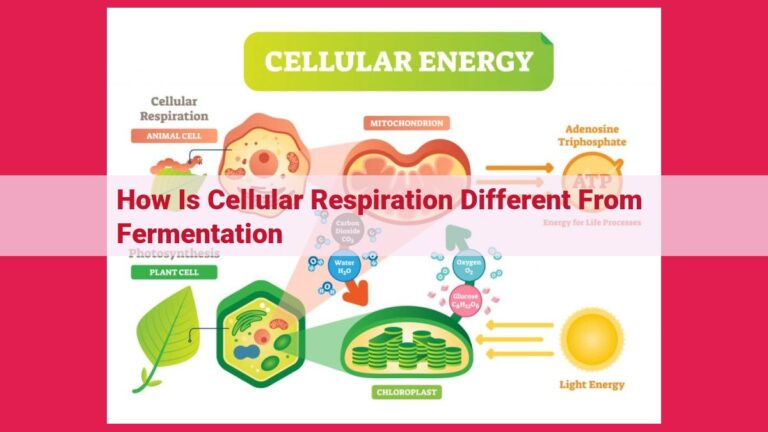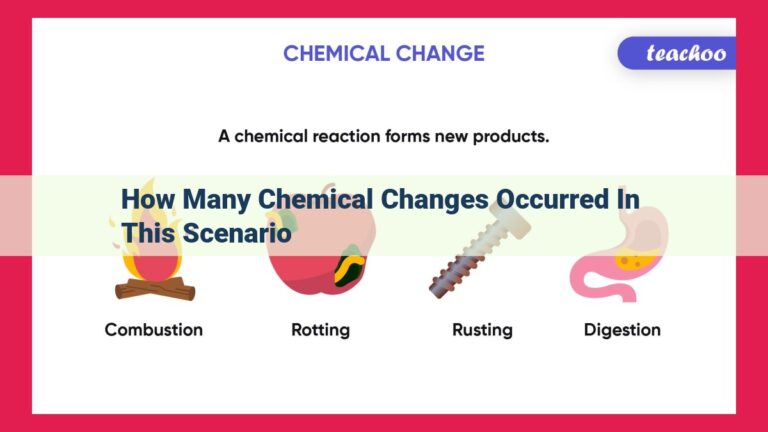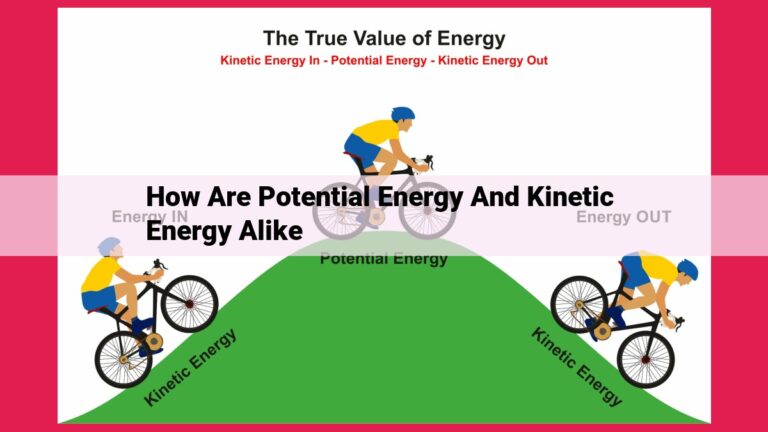Animals: Energy Consumers In Ecosystems
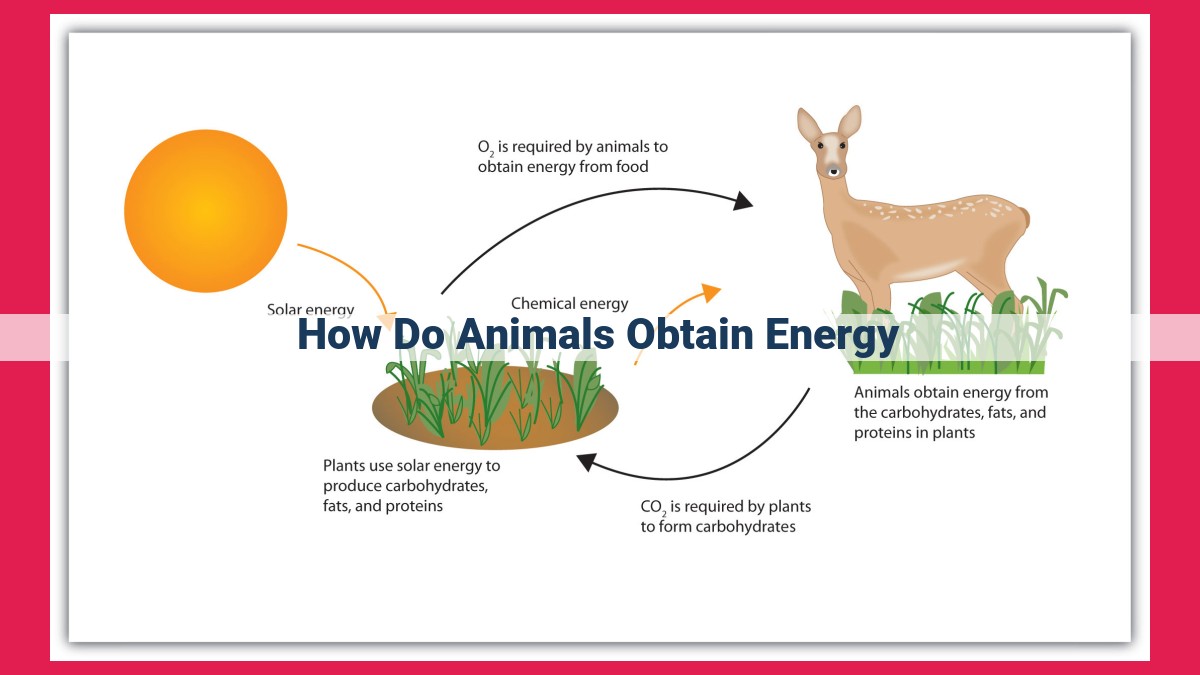
Animals are heterotrophs, meaning they rely on other organisms for energy. They consume plants (herbivores), animals (carnivores), or both (omnivores). Energy flows through ecosystems via food chains, with each trophic level transferring energy to the next. Detritivores and decomposers break down organic matter, recycling nutrients back into the ecosystem. Animals obtain energy through cellular respiration, breaking down food to release ATP, the universal energy currency for cells.
Energy and Food: The Cornerstone of Life Processes
At the heart of all life on Earth lies a fundamental relationship between energy and food. Energy drives every biological function, from the beating of our own hearts to the movement of plants in response to sunlight. Food is the fuel that provides us with the energy we need to survive and thrive.
Energy: The Fuel of Life
Energy is the capacity to do work or produce change. It comes in various forms, including heat, electricity, and chemical energy. Life processes require a continuous supply of energy to function properly.
Power is the rate at which energy is used or transformed. Imagine driving a car; the faster you go, the more power you need. Similarly, the more complex the life process, the more power it requires.
Food: The Energy Source for Life
Food is the primary source of energy for living organisms. Plants, known as autotrophs, use sunlight and carbon dioxide to create their own food through photosynthesis. Animals, known as heterotrophs, rely on plants or other animals for their energy.
Food Chains and Energy Flow
Energy flows through ecosystems in predictable ways. Autotrophs are the foundation of food chains, converting sunlight into food that can be consumed by herbivores. Herbivores, in turn, are consumed by carnivores, and so on. With each step in the food chain, some energy is lost as heat.
Detritivores and Decomposers: The Recycling Crew
Detritivores, such as worms and insects, consume dead organisms and waste matter. Decomposers, such as bacteria and fungi, break down organic material, releasing nutrients back into the soil. These organisms play a crucial role in nutrient recycling and maintaining ecological balance.
Photosynthesis: Harnessing the Sun’s Energy
Photosynthesis is the process by which plants convert sunlight into chemical energy stored in glucose. This process requires chlorophyll, a green pigment that absorbs sunlight, and carbon dioxide from the air.
Respiration: Releasing Cellular Energy
Respiration is the process by which organisms break down food to release energy. This process requires oxygen and occurs in mitochondria, the “powerhouses” of cells.
Metabolism and ATP: The Energy Currency
Metabolism is the sum of all chemical reactions that occur in an organism. ATP (adenosine triphosphate) is the universal energy currency used by cells. ATP transfers energy between different metabolic reactions, providing the fuel for cellular activities.
Autotrophs: The Unsung Heroes of Life
In the vast tapestry of life, there exists a select group of organisms known as autotrophs, the unsung heroes who possess the remarkable ability to produce their own food. Auto means “self,” and troph means “to feed,” aptly capturing their unique role as the primary energy source for all living beings.
At the heart of their energy production lies the incredible process of photosynthesis, where autotrophs harness the power of sunlight to convert carbon dioxide and water into glucose, the essential fuel that powers life. The most well-known autotrophs are plants, whose verdant chlorophyll molecules absorb and convert sunlight into chemical energy.
But the realm of autotrophs extends beyond the leafy greens we know. Algae, both microscopic and macroscopic, play a vital role in aquatic ecosystems, contributing significantly to the world’s oxygen and food supply. Even some bacteria possess the ability to photosynthesize, harnessing the sun’s energy to create their own sustenance from inorganic compounds.
These diverse autotrophs serve as the foundation of food chains and webs, providing the energy that flows through all levels of the ecosystem. Without their ability to capture and convert sunlight into food, life as we know it would simply not exist.
Heterotrophs: The Consumers of Energy
In the intricate tapestry of life, organisms play diverse roles, and heterotrophs stand out as the consumers, reliant on other organisms for their energy needs. Unlike autotrophs, which harness the sun’s energy through photosynthesis, heterotrophs obtain energy by ingesting organic matter.
They form the majority of Earth’s biodiversity, ranging from the tiniest microorganisms to massive mammals. Herbivores, such as rabbits and deer, graze on plants, consuming the chemical energy stored in their tissues. Carnivores, like lions and wolves, hunt and devour other animals, obtaining energy from their flesh. Omnivores, like humans and bears, have a more flexible diet, consuming both plants and animals.
Each of these consumer groups plays a crucial role in maintaining the balance of ecosystems. Herbivores regulate plant growth by grazing, while carnivores limit the populations of their prey. Omnivores, with their diverse diets, help regulate both plant and animal communities.
However, the relationship between heterotrophs and their food sources goes beyond mere consumption. Heterotrophs also decompose organic matter, returning nutrients back into the ecosystem. This process, known as detritivory, is carried out by organisms such as worms, insects, and fungi. By breaking down dead plant material and animal carcasses, detritivores facilitate nutrient cycling and contribute to soil fertility.
Therefore, while heterotrophs may not produce their own energy, their role as consumers and decomposers is essential for the functioning of ecosystems. They weave a complex web of interactions, ensuring the continuous flow of energy and nutrients that sustains life on Earth.
Trophic Levels and the Flow of Energy in Food Chains
In the intricate tapestry of life on Earth, every living organism plays a crucial role in the energy cycle. Food chains are a simplified representation of this complex network, illustrating the pathways of energy flow within an ecosystem.
Trophic Levels: A Hierarchy of Energy
Within a food chain, organisms are arranged into distinct levels based on their feeding habits. The foundation of this hierarchy is occupied by the autotrophs, or primary producers. These are organisms that can harness the sun’s energy through photosynthesis or derive their energy from inorganic molecules.
The next level includes herbivores, animals that consume plants and other autotrophs. These herbivores serve as an energy source for carnivores, animals that feed on other animals. The highest trophic level is occupied by apex predators, carnivores that stand at the pinnacle of the food chain with no natural predators.
The Energy Cascade: From Sun to Cells
Energy enters the food chain through photosynthesis, the process by which autotrophs use sunlight to convert carbon dioxide and water into organic molecules that store energy. As herbivores consume autotrophs, they transfer this energy to their own bodies. Carnivores, in turn, acquire energy by consuming herbivores.
At each stage of energy transfer, some energy is lost as heat due to the inefficiency of biological processes. As a result, the amount of energy available at higher trophic levels decreases. Therefore, food chains typically consist of only a few trophic levels, with fewer organisms at each level.
Ecological Significance: Balance and Interdependence
In a healthy ecosystem, the flow of energy through food chains is balanced. This ensures that each trophic level has sufficient energy to sustain its population. Each species also plays a crucial role in maintaining the stability of the ecosystem by preying on other species and keeping populations within appropriate limits.
Understanding food chains not only helps us unravel the intricate relationships within ecosystems but also highlights the interdependence of all living organisms. Each species, from the smallest autotroph to the largest apex predator, contributes to the overall functionality of the natural world.
Detritivores and Decomposers: The Recycling Brigade
Imagine a world without decomposers, where fallen leaves, dead animals, and decaying plant matter piled up endlessly. Our planet would be suffocating under a blanket of waste, and life as we know it would cease to exist.
Enter the detritivores and scavengers, the unsung heroes of the natural world. These creatures, from tiny insects to massive vultures, play a vital role in breaking down organic matter, releasing essential nutrients back into the ecosystem.
Detritivores, such as earthworms, snails, and dung beetles, feed on decaying plant material. They are nature’s janitors, tirelessly turning dead vegetation into nutrient-rich soil that supports new plant growth.
Scavengers, like vultures, hyenas, and crabs, scour the environment for dead animals. By removing carcasses, they prevent the spread of disease and recycle valuable nutrients back into the food chain.
As detritivores and scavengers perform their messy work, they create a feast for another group of decomposers: bacteria and fungi. These microscopic organisms are the ultimate recyclers, breaking down organic matter into its elemental components.
Bacteria and fungi produce enzymes that dissolve complex compounds, releasing nutrients into the soil and water. These nutrients can then be taken up by plants, completing the cycle of life and death.
The role of detritivores and decomposers in nutrient recycling cannot be overstated. Without them, the Earth’s ecosystems would collapse, and life would grind to a halt. These creatures are essential to our planet’s health and remind us that even the most unappealing organisms play a crucial role in the delicate balance of nature.
Photosynthesis: Harnessing the Sun’s Gift of Life
In a world teeming with vibrant greenery, a profound dance unfolds – a dance of life, fueled by the radiant energy of the sun. This enchanting ballet is photosynthesis, the process that transforms sunlight into the energy that sustains our planet.
At the heart of photosynthesis lies chlorophyll, a pigment that resides within the chloroplasts of plant cells. Like microscopic solar panels, these chloroplasts capture the sun’s golden rays, kickstarting a remarkable chain of events.
As the sun’s energy penetrates the chloroplasts, it interacts with water molecules, splitting them into hydrogen and oxygen. This process, called photolysis, is a crucial step in photosynthesis. The free hydrogen then combines with carbon dioxide, forming glucose, a simple sugar that serves as the foundational energy source for all living organisms.
The significance of photosynthesis in our ecosystem cannot be overstated. It not only provides the food we eat but also releases the oxygen we breathe. Moreover, it plays a pivotal role in regulating the Earth’s climate, absorbing carbon dioxide from the atmosphere and releasing it back as part of the natural carbon cycle.
So, as you bask in the warmth of the sun, remember the intricate symphony of photosynthesis that is taking place all around you, nourishing the world and sustaining life as we know it.
Respiration: The Energy Release Process
- Explain the process of respiration, which breaks down food to release energy.
- Highlight the importance of oxygen and mitochondria in respiration.
Respiration: The Energy Release Process
Just like you need fuel to power your car, living organisms require energy to sustain their everyday functions. This is where respiration plays a crucial role. Respiration is a process that converts the chemical energy stored in food molecules into a usable form for cells. But how does this magical energy transformation happen?
The Players in the Respiration Game
Two key players are involved in this energy-yielding process: oxygen and mitochondria. Oxygen acts as the electron acceptor, while the mitochondria are the powerhouses of the cell, where respiration takes place.
The Cellular Powerplant: Mitochondria
Imagine the mitochondria as tiny factories that break down food molecules and produce energy. These organelles contain specialized compartments called cristae, which have a large surface area to accommodate the enzymes responsible for respiration.
The Energy Extraction Process
Respiration occurs in three stages: glycolysis, the Krebs cycle, and oxidative phosphorylation. Glycolysis takes place in the cytoplasm, where glucose (the sugar molecule) is broken down into simpler compounds. The Krebs cycle then occurs within the mitochondria, releasing carbon dioxide and generating high-energy molecules like NADH and FADH2.
Oxidative Phosphorylation: The Energy Payoff
The final stage, oxidative phosphorylation, is where the real energy gain happens. NADH and FADH2 donate high-energy electrons to the electron transport chain, creating an electrochemical gradient. This gradient drives the ATP synthase enzyme to generate ATP, the universal energy currency of cells.
The Importance of Oxygen
Why is oxygen so crucial in this process? Because it’s the final electron acceptor in the electron transport chain. Without oxygen, respiration would be incomplete, and the energy yield would be significantly lower.
Respiration: The Foundation of Life
Respiration is not just a biological process; it’s the foundation of all life on Earth. It provides the energy that drives every living organism, from the smallest bacteria to the largest whales. So, the next time you take a deep breath, appreciate the vital role it plays in fueling your body’s every move.
Metabolism and ATP: The Energy Powerhouse of Life
Metabolism: The Unseen Engine of Life
Imagine your body as a bustling metropolis, teeming with countless biochemical reactions. This vibrant city is where metabolism takes center stage, the process that powers every aspect of your existence. Metabolism is like a master chef, orchestrating chemical reactions that transform food into energy, building materials, and waste.
Enzymes: The Chemical Catalysts
Within this metabolic tapestry, enzymes play a crucial role. These tiny molecular machines act as catalysts, accelerating chemical reactions that would otherwise proceed at a snail’s pace. Enzymes are incredibly specific, each one designed to interact with a particular substrate and facilitate a specific reaction.
ATP: The Universal Energy Currency
At the heart of metabolism lies ATP (adenosine triphosphate), the universal energy currency of cells. Think of ATP as the fuel that powers all cellular activities, from muscle contraction to nerve impulses. ATP is generated through the breakdown of food during cellular respiration, a process that harnesses the energy stored within chemical bonds.
Respiration: The Energy Extraction Process
Cellular respiration is the driving force behind ATP production. In essence, respiration is the controlled combustion of food molecules, releasing energy in the form of heat and chemical bonds. The key player in this process is oxygen, which combines with glucose (a sugar derived from food) to produce carbon dioxide and water, along with a significant amount of ATP.
The Metabolic Symphony
Metabolism is a complex and intricate process that underpins the very essence of life. From the pulsing heart to the firing neurons, every function relies on the steady flow of energy generated through metabolism. ATP, the universal energy currency, serves as the fuel for this metabolic symphony, ensuring that our bodies continue to thrive and adapt in an ever-changing world.

